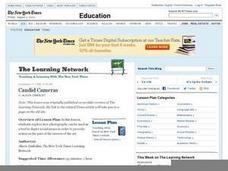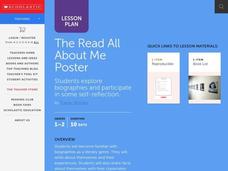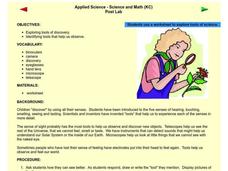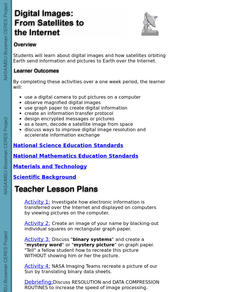Curated OER
There's a Monster in My Classroom
Students work in groups making drawing of monsters and then given written instructions to students in another class about how to draw the same monster. After the drawings are complete, they share with other students using an iSight...
Curated OER
Topo Triangulation
Students investigate how to read a topographical map and triangulate with just a map. They convert a compass measurement to a protractor measurement, reverse a bearing direction, and using a worksheet take a bearing of certain landmarks...
Curated OER
Exploring Film Genres for Telling Hero Stories: Narrative Shorts
Students research that a narrative film tells a story using camera movement, sound, lighting, editing and other film making techniques. The audience must be taken into consideration when making a film. They explore what makes their hero...
Curated OER
Think Fast! What Would You Do If . . .
Fifth graders use critical thinking and problem solving skills. It allows students to make choices and to use imagination to develop a solution for each problem. Solutions are then presented to the class.
Curated OER
Health Education: Stress 2
Fourth graders investigate how to deal with stress. In this personal health lesson plan, 4th graders identify family, school, and community resources as sources of social support to reduce or prevent stress.
Curated OER
TE Lesson: Tsunami Attack!
Students examine how earthquakes, volcanoes, and landslides can trigger tsunami waves. They determine how engineers use sensors to detect the dangerous wave, and how they help design building that will survive the wave force and water.
Curated OER
Asteroids!
Students explore how to visually identify asteroids in SDSS images. They are able to explain that stars are so far away that they do not appear to move, even over the course of a human lifespan. Students identify the location of most...
Curated OER
Yes We Can! Students with Autism & Down-Syndrome on the Drums!
To learn about various topics and improve their social skills, learners with special needs play along with music on drums and other sound objects. Teachers take digital pictures of the students participation and use them to make bulletin...
Curated OER
Simulation of Laparoscopic Surgery Lab
Students, having learned how to manipulate the instruments, insert the instruments into the "ports" of the plastic membrane, trying to clip, cut, staple the sponge organ according to the function of the instrument.
Curated OER
Candid Cameras
Learners read a New York Times article associated with the use of photography as a tool to depict social issues in order to provoke action. They create a Social Issues display.
Curated OER
Happy Birthday to You
Young scholars explore how people celebrate traditional holidays in various cultures. They participate in activities that are used to celebrate birthdays in different cultures. Students analyze the celebrations.
Curated OER
The All About Me Poster
Learners write about themselves and create a poster to illustrate who they are.
Hump Software
The Writing Machine
Introduce your learners to the letters of the alphabet. They will tap to hear the name of each letter and see a word beginning with that letter appear on the screen. The highly repetitive nature of this app could be a good way to...
Howard Hughes Medical Institute
WildCam Gorongosa
After years of war and unrest, how quickly will nature recover? Started as a project to track lion populations, WildCam Gorongosa now tracks many species. Through hidden camera evidence, scientists know species are returning to the area....
Lakeshorelearning
Read and Write about It
Reading informational text is a skill that transcends subjects and grade levels. Practice reading about different topics in various formats with a language arts lesson that includes opportunities for writing and research as well.
Curated OER
Use of Digital Cameras
Students become familiar with the operation of the school digital camera. They insert photographs into WORD procession software and use text boxes and arrows to create labels.
Curated OER
It's Fun to Learn!
Students use the macro mode of the OLYMPUS FE-140 CAMERAS as virtual microscopes to explore different habitats, observe plants, soil, and insects and other creatures. They download those images on electronic files and build web pages....
Curated OER
Applied Science - Science and Math Post-Lab
Students use scientific tools. In this Applied Science lesson, students investigate the use of scientific tools to enhance observation and discovery. Students indicate how each tool assists scientific work.
Curated OER
All About Me
Students produce a slide show documentary designed to help them recognize their individuality, respect each other's differences, and discover what makes them unique. They examine the concept of digital portfolios. It is designed to...
Curated OER
Old Photographs: Windows to the Past
Students examine several types of old photographs and compare them to photography today. Students search for historical photographs and draw conclusions about the time period from the subject matter. Students explain how a camera...
Curated OER
Digital Images: From Satellites To The Internet
Students examine digital images and how satellites orbiting Earth send information and pictures to Earth over the Internet. They use a digital camera to put pictures on a computer and decode a satellite image from space.
Curated OER
Essential to Autumn: Line, Shape, Color, Texture, Pattern, Rhythm, Emphasis, Movement, Balance, and Unity
Students explore the environment by learning about nature. In this art lesson, students go on a walk and find objects to help in creating a picture, or collage representing whatever season is being discussed. Students write similes...
Curated OER
How Animals Meet Their Needs
Fourth graders research the Internet for facts relating to the animal of their choice. They use information from their Internet search to complete their animal project. TLW use his or her own words when writing their report.
Curated OER
Using Science to Explore
In this science technology activity, students will read about how robots have helped scientists explore areas that humans cannot. Students will complete 2 short answer questions based on the reading.























